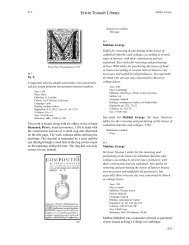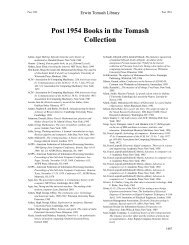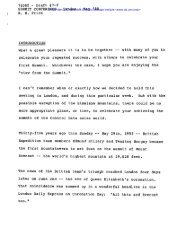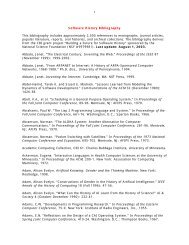B chapter.indd - Charles Babbage Institute - University of Minnesota
B chapter.indd - Charles Babbage Institute - University of Minnesota
B chapter.indd - Charles Babbage Institute - University of Minnesota
You also want an ePaper? Increase the reach of your titles
YUMPU automatically turns print PDFs into web optimized ePapers that Google loves.
154<br />
Pagination: pp. 28<br />
Collation: A–C 4 E 2<br />
Size: 258x201 mm<br />
Reference: Pogg Vol. I, p. 200; Gun AOW II, 319<br />
See also the entry for Bird, John; The method <strong>of</strong> dividing<br />
astronomical instruments, 1767, London.<br />
This volume is the second half <strong>of</strong> Bird’s commitment to<br />
produce a full description <strong>of</strong> how he created the 8-foot<br />
mural quadrant. It is interesting in that Bird describes<br />
not only the details <strong>of</strong> his successful construction <strong>of</strong><br />
the quadrant but also his failures (such as an attempt to<br />
create the telescope without bracing).<br />
Illustrations available:<br />
Title page<br />
B 168<br />
Bird, John (1709–1776)<br />
The method <strong>of</strong> dividing astronomical instruments.<br />
Year: 1767<br />
Place: London<br />
Publisher: J. Nourse; and Mess. Mount and Page<br />
Edition: 1st<br />
Language: English<br />
Figures: 1 large engraved folding plate<br />
Binding: later paper wrappers<br />
Pagination: pp. vi, 14<br />
Collation: A–E 2<br />
Size: 258x201 mm<br />
John Bird was a major instrument maker in London.<br />
He began his career as a weaver but soon developed a<br />
part-time business helping watch face makers. He later<br />
worked for an instrument maker named Graham before<br />
opening his own instrument shop. He was commissioned<br />
to construct a large (8-foot radius) mural quadrant at<br />
the Royal Observatory at Greenwich (completed in<br />
1749) when the earlier one done by Graham began to<br />
deform under its own weight. The Commissioners <strong>of</strong><br />
Longitude (and, in particular, the Astronomer Royal,<br />
Neville Maskelyne) were responsible for the quadrant’s<br />
construction and wanted to ensure that the methods used<br />
by Bird (then in business for some thirty-four years)<br />
would be available to his successors. In return for a sum<br />
<strong>of</strong> £500 (plus an additional £60 for engraved plates), Bird<br />
agreed to take an apprentice and instruct him for seven<br />
years and to present to the commissioners a full and<br />
complete description <strong>of</strong> how the quadrant scales were<br />
divided. This volume is the fulfillment <strong>of</strong> the written<br />
part <strong>of</strong> that commitment. The quadrant had actually been<br />
constructed seventeen years earlier, and one can presume<br />
that the commissioners were anxious to have all the plans<br />
and descriptions finished.<br />
Erwin Tomash Library<br />
Bird, John Birkh<strong>of</strong>f, Garrett<br />
Great care was obviously taken with the division <strong>of</strong> the<br />
scales. Bird describes how the brass quadrant scales and<br />
the pine beam compasses were left in a locked room over<br />
night so that they might stabilize to the same temperature.<br />
He also sketches out a method <strong>of</strong> dividing a scale by<br />
establishing a few elementary basic measurements and<br />
then using repeated bisections to create the other marks.<br />
The one diagram is marked Plate iv because it is the<br />
fourth plate from his engraved plates <strong>of</strong> the quadrant (see<br />
entry for Bird, John; The method <strong>of</strong> constructing mural<br />
quadrants. Exemplified by a description <strong>of</strong> the brass<br />
mural quadrant in the Royal Observatory at Greenwich,<br />
1768, for the other three).<br />
Illustrations available:<br />
Title page<br />
B 169<br />
Birkh<strong>of</strong>f, Garrett (1911–); K. O. Friedrichs and T. E.<br />
Sterne, editors<br />
Transactions <strong>of</strong> the symposium on fluid mechanics and<br />
computing held at New York <strong>University</strong>, April 23–24,<br />
1953. The first symposium on applied mathematics<br />
sponsored by the American Mathematical Society and<br />
Office <strong>of</strong> Ordnance Research, U. S. Army<br />
Year: 1954<br />
Place: New York<br />
Publisher: Interscience Publishers<br />
B 168







